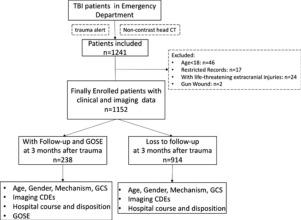Journal of Neuroradiology ( IF 3.5 ) Pub Date : 2019-07-16 , DOI: 10.1016/j.neurad.2019.07.002 Hui Chen 1 , Ying Li 2 , Bin Jiang 3 , Guangming Zhu 3 , Paymon Garakani Rezaii 3 , Gang Lu 4 , Max Wintermark 3

|
Purpose
To characterize the demographics, clinical and imaging findings, and outcomes of traumatic brain injury (TBI) patients in each of NeuroImaging Radiological Interpretation System (NIRIS) categories.
Material and methods
We considered all consecutive patients transported to Stanford Hospital's emergency department by ambulance or helicopter between November 2015 and April 2017. We retained adult patients (> 18 years old) for whom a trauma alert was triggered and who underwent a non-contrast head computer tomography (CT) because of suspected TBI. We reviewed the non-contrast CT scans in these patients for the NIH TBI common data elements (CDEs). We recorded, then assessed differences in terms of demographics, clinical characteristics, imaging CDEs, and outcomes in patients from the different NIRIS categories.
Results
In all, 1152 patients were included in this study. Patients with NIRIS 0 imaging findings were significantly younger than patients in other NIRIS categories (P < 0.001). Motor vehicle accidents and falls from height were the most common mechanisms of injury across NIRIS categories. GCS scores decreased with increasing NIRIS category imaging findings and were significantly lower in patients with NIRIS 4 imaging findings (P < 0.001). Significant differences in NIRIS categories were observed for all imaging CDEs (P < 0.001), in agreement with the definition of the different NIRIS categories. Mortality increased progressively with increasing NIRIS severity.
Conclusions
TBI patients in different NIRIS categories have different clinical characteristics, hospital courses and outcomes. This natural history assessment of patients from different NIRIS categories could thus serve as a reference standard for future TBI clinical trials.
中文翻译:

不同神经影像放射判读系统 (NIRIS) 类别中急性创伤性脑损伤患者的人口统计学和临床特征
目的
表征每个神经影像放射学解释系统 (NIRIS) 类别中创伤性脑损伤 (TBI) 患者的人口统计学、临床和影像学发现以及结果。
材料与方法
我们考虑了 2015 年 11 月至 2017 年 4 月期间通过救护车或直升机送往斯坦福医院急诊室的所有连续患者。我们保留了触发创伤警报并接受非对比头部计算机断层扫描的成年患者(> 18 岁)。 CT),因为疑似 TBI。我们审查了这些患者的非对比 CT 扫描以获取 NIH TBI 通用数据元素 (CDE)。我们记录并评估了来自不同 NIRIS 类别的患者在人口统计学、临床特征、成像 CDE 和结果方面的差异。
结果
总共有 1152 名患者参与了这项研究。NIRIS 0 成像结果的患者明显比其他 NIRIS 类别的患者年轻(P < 0.001)。机动车事故和高处坠落是 NIRIS 类别中最常见的伤害机制。GCS 评分随着 NIRIS 类别成像结果的增加而降低,并且在具有 NIRIS 4 成像结果的患者中显着降低 ( P < 0.001)。对于所有成像 CDE,观察到 NIRIS 类别的显着差异(P < 0.001),与不同 NIRIS 类别的定义一致。死亡率随着 NIRIS 严重程度的增加而逐渐增加。
结论
不同 NIRIS 类别的 TBI 患者具有不同的临床特征、住院过程和结果。因此,这种对来自不同 NIRIS 类别的患者的自然史评估可以作为未来 TBI 临床试验的参考标准。



























 京公网安备 11010802027423号
京公网安备 11010802027423号